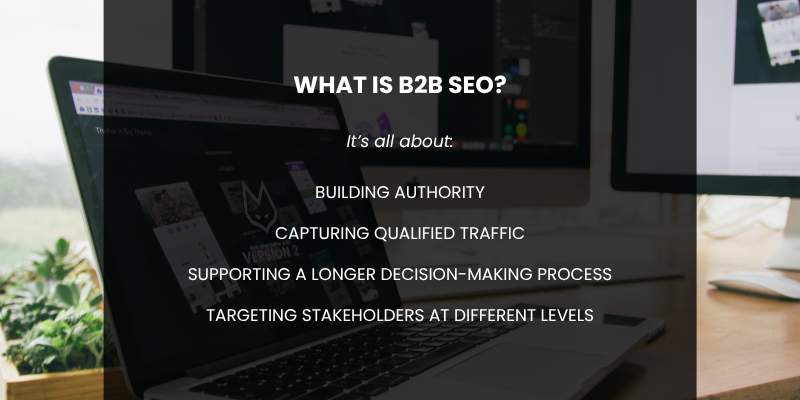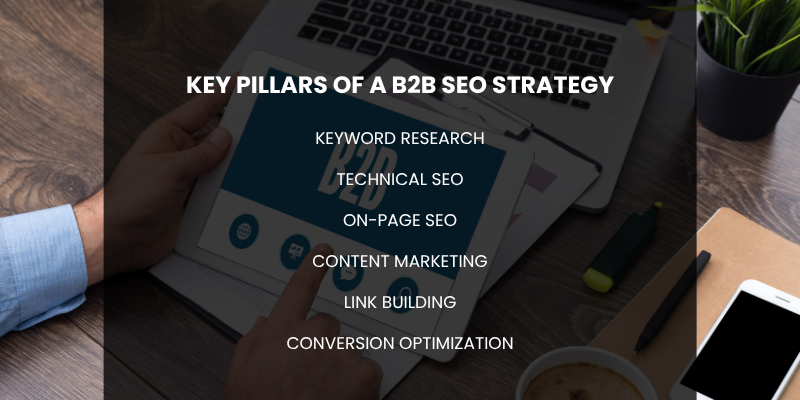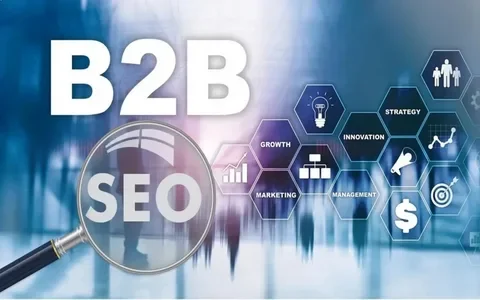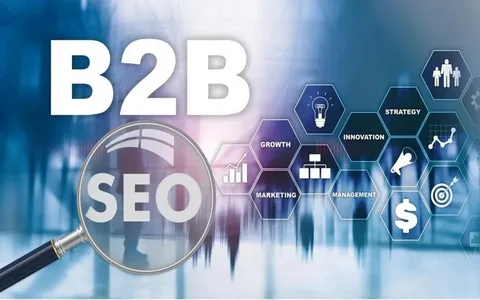Search engine optimization (SEO) has traditionally been associated with consumer-facing brands, particularly in the B2C (business-to-consumer) sector.
As more companies shift towards digital-first strategies, having a solid SEO foundation is no longer optional it’s necessary for growth and success.
B2B SEO focuses on optimizing a company’s online presence to attract, engage, and convert business clients rather than individual consumers.
When considering B2B vs B2C, the approach to SEO differs greatly, with B2B emphasizing lead generation, thought leadership, and driving qualified traffic, compared to B2C’s focus on quick conversions and impulse buying.
Unlike B2C SEO, which often targets quick conversions and impulse buying, B2B SEO focuses on lead generation, establishing thought leadership, and driving qualified traffic.
The goal is to engage potential clients through content that speaks to their pain points, showcase industry expertise, and ultimately guide them toward making high-value decisions.
In this guide, we’ll explore what B2B SEO is, how it differs from traditional SEO, and the essential strategies that will help your business thrive in a competitive market.
What is B2B SEO?

B2B SEO (Business-to-Business SEO) is the process of optimizing a website to improve its visibility and ranking in search engine results pages (SERPs), with the specific goal of attracting business clients rather than individual consumers.
Unlike B2C SEO, which is often focused on targeting quick, impulse buys, B2B SEO takes a more strategic approach, emphasizing the following:
- Building Authority: Establishing your business as a trusted leader in your industry.
- Capturing Qualified Traffic: Attracting decision-makers and professionals who are actively seeking solutions.
- Supporting a Longer Decision-Making Process: Recognizing that B2B purchases often involve longer research and multiple stakeholders.
- Targeting Stakeholders at Different Levels: Crafting content that appeals to various roles within an organization, from decision-makers to technical experts.
A critical element in this strategy is understanding what is CTA, as crafting the right call-to-action helps guide potential clients through each stage of the buyer’s journey.
Why is SEO Important for B2B Companies?
SEO plays a pivotal role in the success of B2B companies. With 70% of B2B buyers starting their research online, it is essential for businesses to have a strong SEO presence to be discoverable at the right moment.
In fact, when considering what are five marketing strategies that retailers spend half of their annual budget on? SEO is often one of the top strategies, helping businesses gain long-term visibility.
One of the most significant advantages of SEO is that it reduces dependency on paid ads, offering a long-term ROI that ensures sustainable growth without relying solely on paid campaigns.
Additionally, SEO helps establish thought leadership and brand authority by promoting high-quality, relevant content that builds trust among potential clients.
It also captures valuable traffic across all stages of the buyer’s journey top, middle, and bottom-of-funnel cost-effectively, allowing businesses to attract leads at various points in their decision-making process.
B2B SEO vs. B2C SEO
The main difference between B2B SEO and B2C SEO lies in the audience they target and the approach to conversion.
B2B SEO focuses on business stakeholders and decision-makers within organizations, while B2C SEO targets individual consumers.
For instance, marketing tactics in B2C are often driven by immediate needs or impulse buying, while in B2B, the process is more strategic, aimed at building relationships over time.
This distinction greatly affects the sales cycle; B2B sales tend to be longer and more complex, involving multiple stakeholders and a more detailed evaluation process, whereas B2C sales are often shorter and driven by impulse purchases or quick decisions.
In terms of content, B2B SEO requires creating in-depth and educational material that addresses specific business needs and pain points, offering solutions and guiding potential clients through a detailed decision-making process.
On the other hand, B2C SEO focuses on creating advertisement examples that engage consumers emotionally and encourage immediate purchases.
The keywords used in B2B SEO tend to be more niche and low volume, targeting specific industries or professional terms, while B2C SEO relies on broad and high-volume keywords aimed at attracting a larger audience.
As for goals, B2B SEO primarily seeks to generate leads, demos, and consultations, whereas B2C SEO is focused on driving sales and sign-ups.
Consequently, the key KPIs differ B2B SEO measures success through MQLs (Marketing Qualified Leads), traffic quality, and engagement, while B2C SEO tracks metrics like CTR (Click-Through Rate), conversions, and cart value.
Key Pillars of a B2B SEO Strategy

The key pillars of a B2B SEO strategy include keyword research, technical SEO, on-page optimization, content marketing, link building, and conversion optimization to drive qualified traffic and generate leads. As an example of keyword research, consider keywords like "best SEO reporting tools" or "AI SEO software", which can help guide your strategy to target more refined business audiences.
1. Keyword Research
Effective keyword research is crucial for driving the right traffic to your B2B site. Focus on bottom-of-funnel (BOFU) and solution-aware terms, as these terms reflect users who are closer to making a purchasing decision.
For instance, keywords like “Best project management software for construction” or “How to automate warehouse inventory” attract highly targeted traffic.
Utilize tools like Ahrefs, SEMrush, and Google Search Console to identify keywords that align with your business offerings and buyer intent.
Make sure to prioritize long-tail and intent-based keywords that are more specific and less competitive. Including both transactional and informational keywords ensures you target customers at various stages of their journey.
Incorporating LinkedIn marketing into your keyword research can also help you reach professionals actively engaging in business-focused discussions.
2. Technical SEO
A strong technical foundation is essential for B2B SEO. Fast load times, mobile responsiveness, and a clean site architecture are key elements to improve both user experience and search engine rankings.
Address any crawl errors and optimize your robots.txt, sitemaps, and schema markup to enhance site crawlability and visibility.
Securing your website with HTTPS is a must for both trust and SEO. Use canonical tags, implement the correct 301 redirects, and avoid duplicate content to ensure your site is properly indexed.
Onsite and technical SEO plays a critical role in improving the technical aspects that enhance user experience and search engine visibility.
Explore Our Programmatic SEO Services!
3. On-Page SEO
On-page SEO focuses on optimizing individual pages to ensure they are easily understood by both users and search engines.
This includes meta tags, headers (H1-H3), alt text, and URL slugs to ensure clarity and relevancy.
Ensure that your content includes clear internal linking to help users navigate your site easily, while also making sure search engines can crawl and index your pages effectively.
Furthermore, incorporate clear CTAs like “Book a Demo” or “Download Whitepaper” to encourage conversions. Tools like Surfer SEO or Frase can help optimize content and improve on-page SEO performance.
4. Content Marketing
Content marketing is one of the most powerful ways to engage potential B2B clients. Create in-depth content that addresses specific business pain points, such as case studies, product comparisons, webinars, and whitepapers.
When it comes to content strategy, content marketing techniques are critical to providing value and relevance to your target audience.
Explore Our Content Marketing Services!
5. Link Building
Link building is crucial for building domain authority and improving search rankings. Focus on gaining backlinks from authoritative sources such as guest posts, industry directories, resource pages, and digital PR efforts. Advanced link building techniques, such as outreach to high-quality B2B sites and leveraging partnerships, can help you acquire more valuable backlinks. Aim to get links from niche-relevant B2B sites with strong domain authority to ensure you’re building high-quality backlinks that drive traffic and improve SEO performance.
Aim to get links from niche-relevant B2B sites with strong domain authority to ensure you’re building high-quality backlinks that drive traffic and improve SEO performance.
6. Conversion Optimization
Conversion optimization ensures that the traffic you bring in turns into qualified leads, and this is where understanding what is B2B marketing is crucial to structuring a strong call-to-action (CTA) that drives potential clients down the conversion funnel.
Incorporate multiple conversion touchpoints such as CTAs, forms, and chatbots across your site to engage users and encourage them to take action.
Use tools like Hotjar or VWO to gain insights into user behavior through heatmaps and A/B testing, helping you fine-tune your site for maximum conversions. Finally, measure how your
SEO traffic is converting to leads to gauge the effectiveness of your strategy and make necessary adjustments.
B2B SEO Funnel & User Intent

Understanding search intent is important for aligning your content and optimization strategies with the buyer's journey at each stage.
The B2B sales cycle involves decision-makers, and the content should match their intent: "What is network marketing?" could be a query that aligns with users at the awareness stage, trying to understand if a specific business model could work for them.
Here's how different intent types map to various stages of the B2B funnel
- TOFU (Top of Funnel) - Awareness: At this stage, users are seeking informational content to solve a problem or learn more about a topic. The intent is not yet to purchase but to gather insights.
- MOFU (Middle of Funnel) - Consideration: Users in this stage are looking for solutions to their problems and are comparing options. The content should be more navigational or comparative, helping them evaluate their choices.
- BOFU (Bottom of Funnel) - Decision: At this stage, users are ready to make a purchase. The content should be transactional, encouraging the user to take action and convert into a lead or customer.
Your content and optimization efforts should be strategically aligned with each intent type to effectively guide users through the buyer's journey, from awareness to decision-making.
Mapping SEO to the B2B Buyer’s Journey
To effectively guide potential clients through the B2B buyer’s journey, it’s essential to align SEO Services with the content that addresses their needs at each stage
1. Awareness Stage
At the Awareness Stage, potential clients are learning about their problem and exploring possible solutions. Your content should provide valuable, informational resources to attract and educate them.
- Blog posts: Answer common industry questions and provide solutions.
- Educational videos: Help users understand their challenges and potential solutions.
- Infographics: Visually explain complex concepts in an easily digestible format.
2. Consideration Stage
At the Consideration Stage, users are evaluating their options. Here, SEO should focus on providing content that helps them compare and understand different solutions.
- Comparison guides: Highlight the features and benefits of various products or services.
- Webinars: Offer live or recorded sessions to dive deeper into the solutions you're offering.
- Case studies: Showcase how your product or service has helped others in similar situations.
3. Decision Stage
In the Decision Stage, users are ready to choose a solution. Your content should provide all the information they need to make a purchase decision.
Product pages: Provide detailed information about your products or services.
- Testimonials: Build trust with feedback from existing customers.
- Pricing pages: Make it easy for users to understand pricing and make an informed decision.
Make sure SEO supports lead nurturing by structuring your content effectively and ensuring it addresses the right queries at every stage of the buyer’s journey.
Get Your Free SEO Audit Report Today!
Common Challenges in B2B SEO
Common challenges in B2B SEO include low keyword volume with high lead value, targeting multiple decision-makers, long sales cycles, and the complexity of marketing technical products.
1. Low Keyword Volume, But High Value Per Lead
In B2B SEO, the keywords often have lower search volumes compared to B2C, but the value of each lead generated is much higher.
Targeting niche, long-tail keywords is essential, but these may not generate large volumes of traffic. However, the leads that do convert are typically more qualified and valuable, making SEO efforts still worthwhile in the long run.
2. Multiple Decision-Makers
Unlike B2C, B2B purchasing decisions are often made by a group of stakeholders with varying priorities and concerns.
This means content must appeal to multiple personas C-level executives, technical experts, and end-users.
3. Long Sales Cycles
B2B sales cycles are generally longer and more complex, which makes it difficult to attribute SEO success quickly.
Because buyers may engage with content over several months before making a decision, measuring the immediate ROI of SEO efforts is often challenging.
4. Technical Products
B2B companies that offer complex or technical products often face the challenge of creating content that is both optimized for search engines and accessible to potential clients.
This requires a deep understanding of the product and its benefits, and the ability to explain these in a way that resonates with decision-makers while still aligning with SEO best practices.
Overcoming these challenges requires a tailored, strategic approach to SEO that is both technical and customer-focused.
Despite these hurdles, understanding how to learn AI and leverage it in your SEO strategy can give you a competitive edge, helping you scale your efforts efficiently and effectively
Conclusion
B2B SEO is not simply about appearing in search engine results; it's about strategically positioning your business in front of the right audience at the right time.
As more companies adopt digital-first strategies, questions like “is Shopify legit?” or “is affiliate marketing legit?” often arise. To succeed in B2B marketing, answering such queries with clear, value-driven content is essential.
With the right approach, SEO enables you to attract high-quality, targeted leads who are actively searching for solutions relevant to your business.
To achieve this, your SEO strategy should center around a few critical elements: understanding user intent, ensuring your website has a solid technical foundation, and creating value-driven content that speaks directly to the needs of potential clients at each stage of the buying process.
The longer sales cycles and complex decision-making processes in B2B marketing make SEO even more crucial, as it allows businesses to engage prospects early on and nurture them through their journey.
By focusing on these aspects, you can establish your brand as a trusted authority, build relationships, and drive conversions over time.
If your B2B company has been primarily relying on paid advertising or cold outreach, it’s time to shift focus towards SEO. Investing in SEO now may take time to show results, but the payoff will be worth it.
SEO is a long-term strategy that builds momentum and delivers compounding growth, not just in terms of leads but also in brand visibility, authority, and ultimately, revenue.









